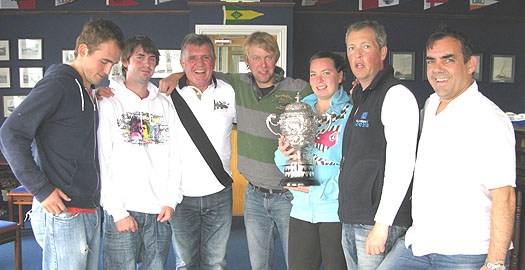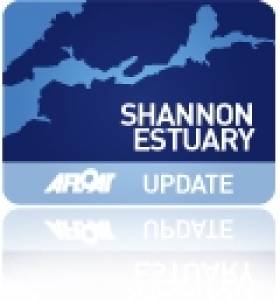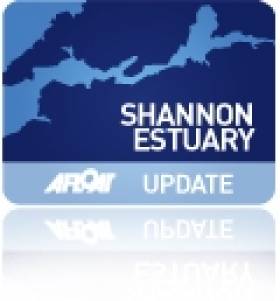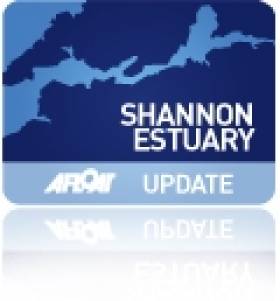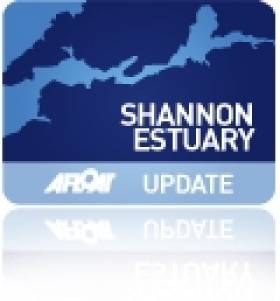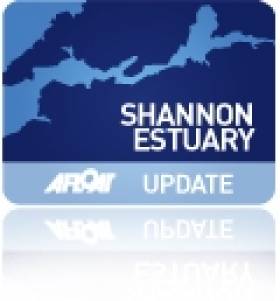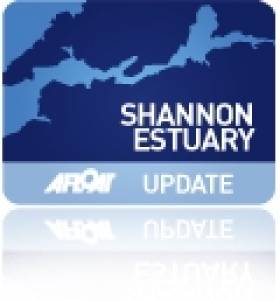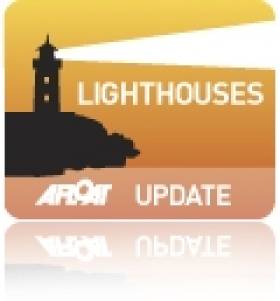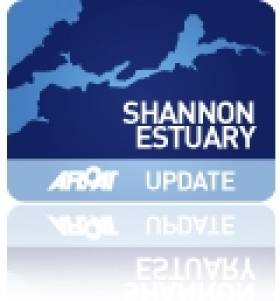Displaying items by tag: Shannon Estuary
#yachtclubs – The antiquity of Irish recreational sailing is beyond dispute, even if arguments arise as to when it started, and whether or not the Royal Cork YC really is the world's oldest club in its descent from the Water Club of the Harbour of Cork from 1720. But all this seems academic when compared with the impression made by relics of Ireland's ancient sailing traditions.
In just six short years, the Royal Cork Yacht Club will be celebrating its Tercentenary. In Ireland, we could use a lot of worthwhile anniversaries these days, and this 300th has to be one of the best. The club is so firmly and happily embedded in its community, its area, its harbour, in Munster, in Ireland and in the world beyond, that it is simply impossible to imagine sailing life without it.
While the Royal Cork is the oldest, it's quite possible it wasn't the first. That was probably something as prosaic as a sort of berth holder's association among the owners of the ornamental pleasure yachts which flourished during the great days of the Dutch civilisation in the 16th and 17th Centuries. They were based in their own purpose-built little harbours along the myriad waterways in or near the flourishing cities of The Netherlands. Any civilisation which could generate delightful bourgeois vanities like Rembrandt's Night Watch, or extravagant lunacies such as the tulip mania, would have had naval-inspired organised sailing for pleasure and simple showing-off as central elements of its waterborne life.
Just sailing for pleasure and relaxation, rather than going unwillingly and arduously afloat in your line of work, seems to have been enough for most. Thus racing – which is the surest way to get some sort of record kept of pioneering activities – was slow to develop, even if inter-yacht matches were held, particularly once the sport had spread to England with the restoration of Charles II in 1660.
Ireland had not the wealth and style of either Holland or England, but it had lots of water, and it was in the very watery Fermanagh region that our first hints of leisure sailing appeared. It's said of Fermanagh that for six months of the year, the lakes are in Fermanagh, and for the other six, Fermanagh is in the lakes. Whatever, the best way to get around the Erne's complex waterways system, which dominates Fermanagh and neighbouring counties, was by boat. By the 16th Century Hugh Maguire, the chief of the Maguires, aka The Maguire, had a Lough Erne-based fleet, some boats of which were definitely for ceremonial and recreational use.
Sport plays such a central - indeed total - role in Irish life that it's highly likely these pleasure sailing boats were sometimes used for racing. However, the first recorded race anywhere in Ireland took place in Dublin Bay in 1663 when the polymath Sir William Petty, having built his pioneering catamaran Simon & Jude, then organised a race with a Dutch sailing vessel and a local "pleasure boatte" of noted high performance. This event, re-sailed in 1981 when the indefatigable Hal Sisk organised the building of a re-creation of the Simon & Jude, resulted both times in victory for the new catamaran. But because a larger sea-going version of the Simon & Jude, called The Experiment at the suggestion of Charles II himself, was later to founder with all hands while on a testing voyage in the Bay of Biscay, the multi-hull notion was abandoned in Europe for at least another two centuries.
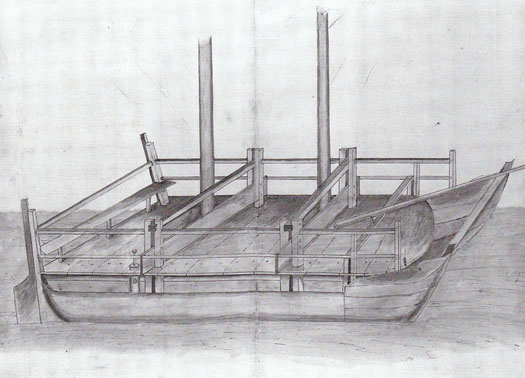
Contemporary drawing of the 17th Century catamaran Simon & Jude, which was built in Dublin and tested in the bay in an early "yacht race" in 1663.
We meanwhile are left wondering just what was this "pleasure boatte" was, and who owned and sailed it. Its existence and good sailing performance seems to have been accepted as unremarkable in Dublin Bay, yet no other record or mention of it has survived.
It was the turbulent life of Munster in the 17th Century which eventually created the conditions in which the first yacht club was finally formed. As the English Civil War spread to Ireland at mid-Century with a mixture of internecine struggle and conquest, the Irish campaigner Murrough O'Brien, the Sixth Baron Inchiquin, changed sides more than once, but made life disagreeable and dangerous for his opponents whatever happened to be the O'Brien side for the day.
Yet when the forces supporting Charles II got back on top in 1660 after the death of Cromwell in 1658, O'Brien was on the winning side. As the dust settled and the blood was washed away, he emerged as the newly-elevated Earl of Inchiquin, his seat at Rostellan Castle on the eastern end of Cork's magnificent natural harbour, and his interests including a taste for yachting acquired with his new VBF Charles II.
But there was much turmoil yet to come with the Williamite wars in Ireland at the end of the 17th Century. Yet somehow as the tide of conflict receded, there seemed to be more pleasure boats about Cork Harbour than anywhere else, and gradually their activities acquired a level of co-ordination. The first Earl of Inchiquin had understandably kept a fairly low profile once he got himself installed in his castle, but his descendants started getting out a bit and savouring the sea. So when the Water Club came into being in 1720, the fourth Earl of Inchiquin was the first Admiral.
In the spirit of the times, having an aristocrat as top man was sound thinking, but this was truly a club with most members described as "commoners", even if there was nothing common about their exceptional wealth and their vast land-holdings in the Cork Harbour area. Much of it was still most easily reached by boat, thus sailing passenger vessels and the new fancy yachts interacted dynamically to improve the performance of both.
Yet there was no racing. Rather, there was highly-organised Admiral Sailing in formation, something which required an advanced level of skill. However, many of the famous club rules still have a resonance today which gives the Water Club a sort of timeless modernity, and bears out the assertion by some historians that, as it all sprang to life so fully formed, the formation date of 1720 must be notional, as all the signs are that there had been a club of some sort for years beforehand.
But either way, it makes no difference to the validity or otherwise of the rival claim, that the Squadron of the Neva at St Petersburg in Russia, instituted by the Czar Peter the Great in 1718 to inculcate an enthusiasm for recreational sailing among Imperial Russia's young aristocrats, was the world's first yacht club. It was no such thing. It was in reality a unit of the Russian navy, and imposed by diktat from the all-powerful ruler. As such, it was entirely lacking the basic elements of a true club, which is a mutual organisation formed by and among equals.
Yet as the Water Club of the Harbour of Cork had no racing with results published in what then passed for the national media, we are reliant on the few existing club records and some travel writing from the time for much of our knowledge of the early days of the Water Club. That, and the Peter Monamy paintings of the Water Club fleet at sea in 1738.
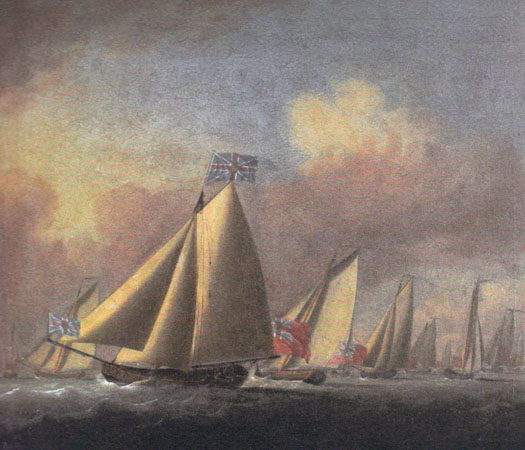
A remarkably well-disciplined fleet. Peter Monamy's 1738 painting of the yachts of the Water Club at sea off Cork Harbour. They weren't racing, but were keeping station in carefully-controlled "Admiral Sailing". Courtesy RCYC
Fortunate indeed are the sailors of Cork, that their predecessors' activities should have been so superbly recorded in these masterpieces of maritime art. The boats may look old-fashioned to a casual observer, yet there's something modern or perhaps timeless in this depiction of the fleet sailing in skilled close formation, and pointing remarkably high for gaff rigged boats as they turn to windward. Only a genuine shared enthusiasm for sailing could have resulted in such fleet precision, and in its turn in a memorable work of art. It is so much part of Irish sailing heritage that we might take it for granted, but it merits detailed study and admiration no matter how many times you've seen it already.
Shortly after Monamy's two paintings were completed, Ireland entered a period of freakish weather between 1739 and 1741 when the sun never shone, yet it seldom if ever rained, and it was exceptionally cold both winter and summer. It is estimated that, proportionately speaking, more people died in this little known famine than in the Great Famine itself 104 years later. While the members of the Water Club would have been personally insulated from the worst of it, the economic recession which struck an intensely agricultural area like Cork affected all levels of society.
Thus the old Water Club saw a reduction in activity, but though it revived by the late 1740s, the sheer energy and personal commitment of its early days was difficult to recapture, and by the 1760s it was becoming a shadow of its former self. Nevertheless there was a revival in 1765 and another artist, Nathanael Grogan, produced a noted painting of Tivoli across from Blackrock in the upper harbour, with a yacht of the Water Club getting under way for a day's recreation afloat, the imminent departure being signalled by the firing of a gun.
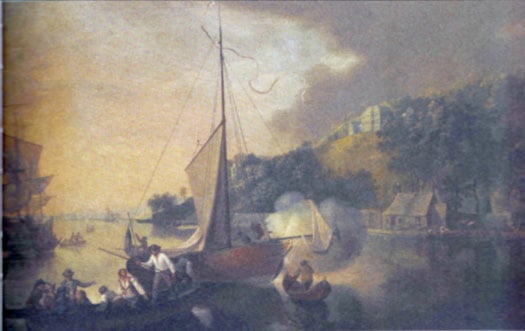
The best way to get the crew on board....on upper Cork Harbour at Tivoli in 1765, a yacht of the reviving Water Club fires a gun to signal imminent departure.
However, it was on Ireland's inland waterways that the next club appeared – Lough Ree Yacht Club came into being in 1770, and is still going strong. That same year, one of the earliest yacht clubs in England appeared at Starcross in Devon, but it was in London that the development pace was being most actively set with racing in the Thames for the Cumberland Fleet. Some members of this group, after the usual arguments and splits which plague any innovative organisation, in due course re-formed themselves as the Royal Thames Yacht Club in the early 1800s. But the famous yet unattributed painting of the Cumberland Fleet racing on the Thames in 1782, while it is slightly reminiscent of Monamy's painting of the Water Club 44 years earlier, undoubtedly shows boats racing. And they'd rules too – note the port tack boat on the right of the picture bearing off to give way to the boat on starboard.
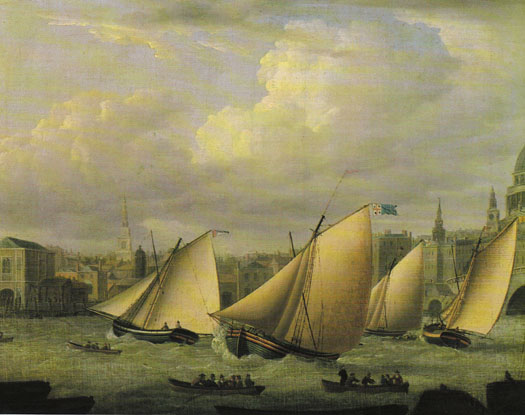
Definitely racing – the Cumberland Fleet, precursor of the Royal Thames Yacht Club, racing in the River Thames at Blackfriars in 1782.
The Thames was wider in those days, but even so they needed strict rules to make racing possible. Dublin Bay offered more immediate access to open water, and there were certainly sailing pleasure boats about. When the Viceroy officially opened the Grand Canal Dock on April 23rd 1796, it was reported that the Viceregal yacht Dorset was accompanied by a fleet of about twenty ceremonial barges and yachts. Tantalisingly, the official painting is almost entirely focused on the Dorset and her tender, while the craft in the background seem to be naval vessels or revenue cutters.
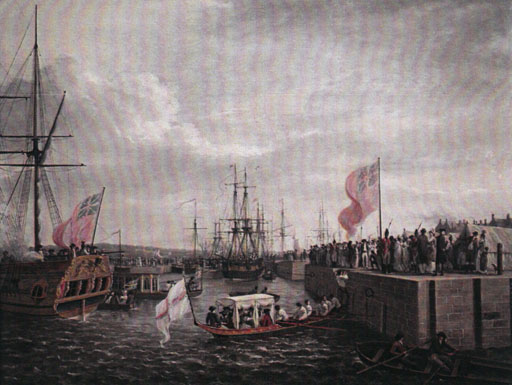
This painting of the opening of the Grand Canal Dock in 1796 tends to concentrate on the ceremonials around the Viceroy's yacht Dorset in the foreground, but fails to show clearly any of the several privately-owned yachts which were reportedly also present....
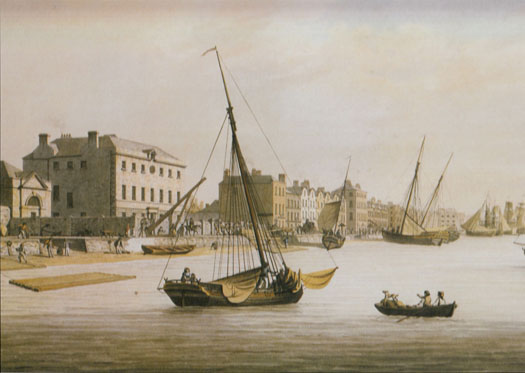
.......but this illustration of the old Marine School on the South Quays in Dublin in 1803 seems to have a yacht – complete with owner and his pet dog on the dinghy in the foreground – anchored at mid-river.
However, a Malton print of the Liffey in 1803 shows clearly what is surely a yacht, the light-hearted atmosphere of waterborne recreation being emphasised by the alert little terrier on the stern of the tender conveying its owner in the foreground Meanwhile in the north of Ireland there was plenty of sailing space in Belfast Lough, while Belfast was a centre of all sorts of innovation and advanced thinking. Henry Joy McCracken, executed for his role in the United Irishmen's rising in 1798, was a keen pioneer yachtsman. As things took a new turn of determined money-making in Belfast after the Act of Union of 1801, some of his former crewmates were among those who formed the Northern Yacht Club in 1824, though it later transferred its activities across the North Channel to the Firth of Clyde, and still exists as the Royal Northern & Clyde YC.
Meanwhile in 1806 the old Water Club of the Harbour of Cork had shown new signs of life, but one result of this was an eventual agreement among members - some of them very old indeed, some representing new blood - that the club would have to be re-structured and possibly even given a new name in order to reflect fresh developments in the sport of yachting. The changeover was a slow business, as it had to honour the club's history while giving the organisation contemporary relevance. Thus it was 1828 before the Royal Cork Yacht Club had emerged in this fully fledged new form, universally acknowledged as the continuation of the Water Club, and incorporating much of its style.
But it was across the north on Lough Erne in 1820 that the world's first yacht club specifically set up to organise racing was formed, and Lough Erne YC continues to prosper today, its alumnae since 1820 including early Olympic sailing medallists and other international champions.
There must have been something in the air in this northwest corner of Ireland in the 1820s, for in 1822 the men who sailed and raced boats on Lough Gill at Sligo had a pleasant surprise. Their womenfolk got together and raised a subscription for a handsome silver trophy to be known as the Ladies' Cup, to be raced for annually – and it still is.
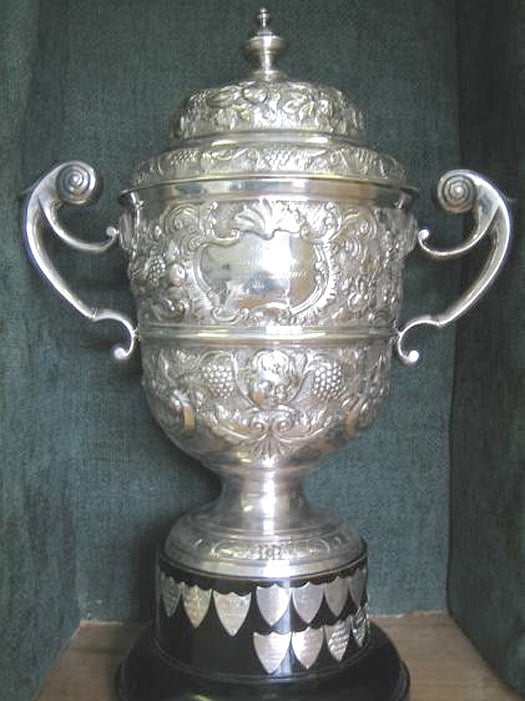
Instituted in 1822, the Ladies' Cup of Sligo YC is the world's oldest continually-contested annual sailing trophy.
Annual challenge cups now seem such a natural and central part of the sailing programme everywhere that it seems extraordinary that a group of enthusiastic wives, sisters, mothers and girlfriend in northwest Ireland were the first to think of it, yet such is the case. Or at least theirs is the one that has survived for 192 years, so its Bicentenary in 2022 is going to be something very special.
Those racing pioneers of the Cumberland Fleet had made do with new trophies freshly presented each year. And apparently the same was the case initially at Lough Erne. But not so very far down the road, at Sligo, somebody had this bright idea which today means that the museum in Sligo houses the world's oldest continually raced-for sailing trophy, and once a year it is taken down the road to the Sligo YC clubhouse at Rosses Point to be awarded to the latest winner – in 2013, it was the ever-enthusiastic Martin Reilly with his Half Tonner Harmony.
The Ladies Cup was won in 2013 by Martin Reilly's Half Tonner Harmony. Pictured with their extremely historic trophy are (left to right) Callum McLoughlin, Mark Armstrong, Martin Reilly, John Chambers, Elaine Farrell, Brian Raftery and Gilbert Henry
However, although the Ladies' Cup may have pioneered a worthwhile trend in yacht racing, it wasn't until 1831 that they thought of inscribing the name of the winner, and that honour goes to Owen Wynne of Hazelwood on the shores of Lough Gill. But by that time the notion of inscribing the winners was general for all trophies, and a noted piece of the collection in the Royal Cork is the Cork Harbour Regatta Cup 1829, and on it is inscribed the once-only winner, Caulfield Beamish's cutter Little Paddy.
The name of noted owner, skipper and amateur yacht designer Caulfield Beamish came up here some time back, when we were discussing how in 1831 he took a larger new yacht to his own design, the Paddy from Cork, to Belfast Lough where he won a stormy regatta. So you begin to understand the mysterious enthusiasm people have for sacred relics when you see this cup with its inscription, and realise that it's beyond all doubt that this now-forgotten yet brilliant pioneer of Cork Harbour sailing development personally held this piece of silverware.
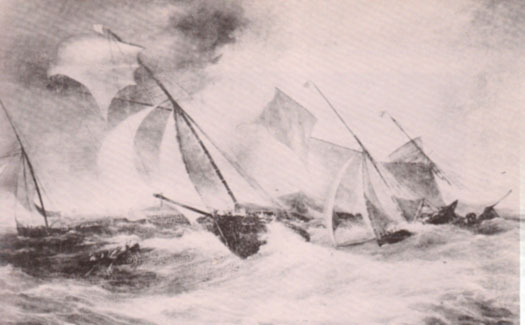
Caulfield Beamish's new cutter Paddy from Cork (which he designed himself) winning a stormy regatta in Belfast Lough in 1831
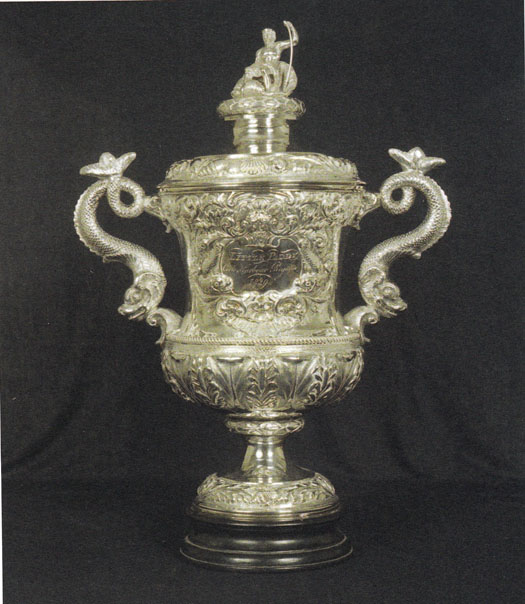
The Cork Harbour Regatta Cup of 1829.....Courtesy RCYC
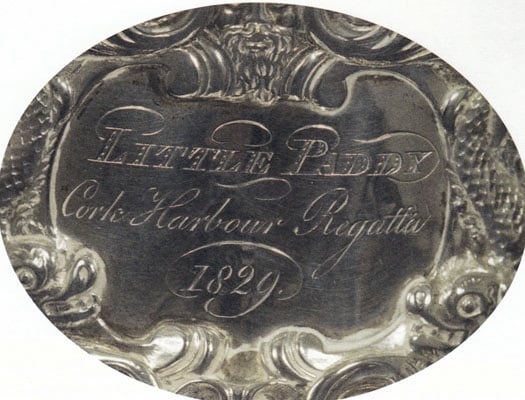
....and on it is inscribed the winner, Caulfield Beamish's earlier boat, Little Paddy, which he also designed himself. Courtesy RCYC
Another pioneer in yacht racing at the time was the Knight of Glin from the Shannon Estuary, who in 1834 was winning all about him with his cutter Rienvelle, his season's haul including a silver plate from a regatta in Galway Bay – it's now in Glin Castle – while he also seems to have relieved fellow Limerick owner William Piercy of £50 for a match race in Cork Harbour against the latter's cutter Paul Pry.
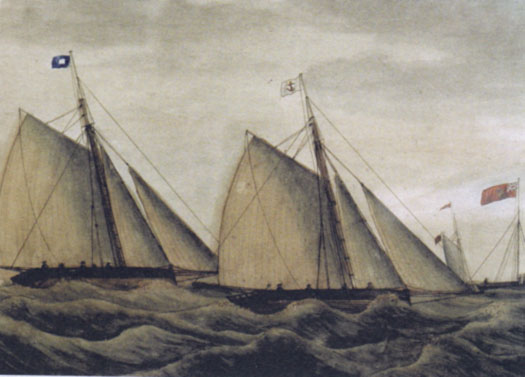
The lads from Limerick hit Cork. William Piercy's Paul Pry racing for a wager of £50 against the Knight of Glin's Rienvelle in Cork Harbour in 1834. When Paul Pry won Cork Harbour Regatta a few weeks later, the band on the Cobh waterfront played Garryowen. Courtesy RCYC
But of all the fabulous trophies in the Royal Cork collection, the one which surely engenders the most affection is the Kinsale Kettle. It goes back "only" to 1859, when it was originally the trophy put up for Kinsale Harbour Regatta. But this extraordinarily ornate piece of silverware was not only the trophy for an annual race, it was also the record of each race, as it's inscribed with brief accounts of the outcomes of those distant contests.
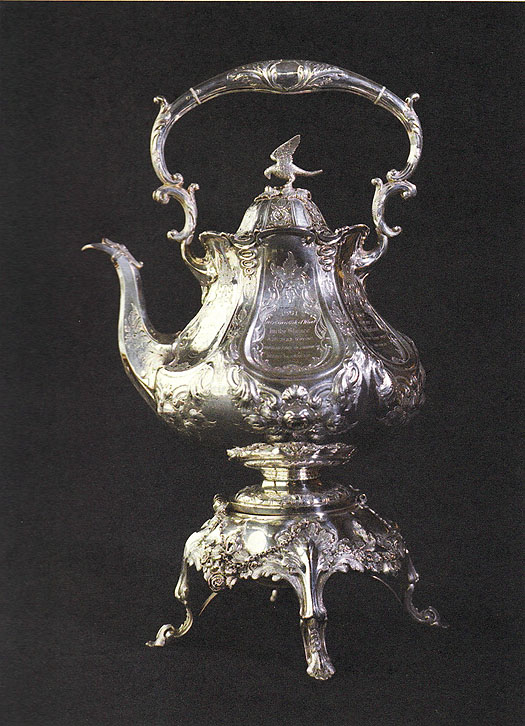
An extraordinary piece of Victorian silverware. The "Kinsale Kettle" from 1859 is now the Royal Cork YC's premier trophy.
Today, it continues to thrive as the Royal Cork Cup, the premier award for Cork Week. The most recent winner in 2012 was Piet Vroon with his superb and always enthusiastic Tonnere de Breskens. The fact that this splendid ambassador for Dutch sailing should be playing such a central role in current events afloat here in Ireland brings the story of our sport's artworks and historical artefacts to a very satisfactory and complete circle.
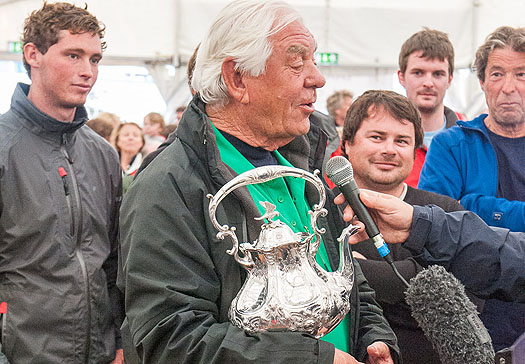
More tea, skipper? The current holder of the Kinsale Kettle, aka the Royal Cork Cup, is Piet Vroon of Tonnere de Breskens. Photo: Bob Bateman
#NEWmaritimeMuseum – Foynes Flying Boat & Maritime Museum reopens today, this will be the first 'full' season to include the maritime section of the visitor attraction since its launch last September, writes Jehan Ashmore.
As previously reported, the maritime museum tells the story of one of Ireland's great maritime assets... the River Shannon. On display are exhibits detailing the geology, personality and mythology of the estuary stretching from Limerick Dock down to Loop Head, marking the mouth of the Shannon at its seaward limits.
As well as interactive technology displays, there are views overlooking Foynes and the port from the recently reinstated control tower that was used for the trans-Atlantic flying boats.
The tower has a balcony (equipped with binoculars) where shipping activity can be directly observed from. Inside the tower there is a photo-montage outlining the various landmarks of the village and estuary.
Also to be seen are Foynes Yacht Club and facing opposite Foynes Island and in the distance Europe's largest alumina refinery plant, the Rusal-owned Aughinish Alumina.
The jetty offshore is where vessels such as Arklow Mill and her sisters are regular callers to the plant.
Charlie McGibney 1928 – 2014
#rip – The sea, once it casts its spell, will hold you in the net of its wonder forever. A thought that left Dublin native Charlie McGibney spellbound for his 85 years. From a very young age and through all his journeys taken over sea and land throughout his long, distinguished and caring life, Charlie took his final journey this week after he peacefully passed away at his home in Tieraclea, Tarbert, County Kerry on February 13 last.
Born in 1928 and originally from Inchicore, Mr McGibney developed and harnessed his interest and love for the sea over many years culminating in stewardship roles with many of the countries national sailing classes and associations.
Through sailing and the his maritime links and bonds, Mr McGibney is fondly remembered throughout the community, both far and wide with the esteem his presence would hold.
A founder member and former Commodore of Tarbert Island Maritime Club, Mr McGibney held a position of governor of RNLI together with a secretariat role for the Topper International Class Association.
A regional race officer with the Irish Sailing Association, Mr McGibney was very much involved with the Mermaid Class Association. A former commodore and member of Foynes Yacht Club as well as Tralee Bay Sailing Club, the avid boat builder was never far from the sea, even in his later years at his Tarbert home.
Co owner of the class winning Dehler Optima 101 yacht 'Disaray' on Ireland's west coast, Mr McGibney was also a member of the West of Ireland Off Shore Racing Association (WIORA) of which his son Simon is Commodore. He was also involved with and a member of the historic Royal Western Yacht Club of Ireland.
Most notably in 2005, aged 77, the able seaman and mariner was the leader of the assault to the Scottish Sailing Series - Tarbert to Tarbert with three generations involved.
At 85 and the beloved husband of the late Ita, Charlie McGibney peacefully passed away leaving behind a wide circle of family and friends. He is survived by daughter Carol; sons, Thomas, George, Gerard, John Raymond, Damien, Rory and Simon, inlaews, grand children and great children.
It is to the land he may lay, but it is to the sea he will look as Mr McGibney's final resting place is at St Mary's New Cemetery following requiem mass at the adjoining church in Tarbert.
Donations, if desired to the RNLI.
Ar dheis de go raibh an anam.
Stricken Tanker Under Tow to Shannon Estuary
#Tanker- The stricken tanker MV Hellesport Charger which lost main engine power off the Clare coast at the weekend is currently under tow at the mouth of the Shannon.
As previously reported, the 16,000dwt chemical oil tanker which had been drifting offshore and carrying 15,000 tonnes of caustic soda was initially given assistance from Naval Service OPV LÉ Aisling (P23) at the request of the Coast Guard.
The vessel had departed Corpus Christi, Texas bound for the Aughinish Alumina plant near Foynes, from where the tug Celtic Rebel joined another tug, the Thrax in the towage operations.
Stricken Tanker Under Tow to Shannon Estuary
#Tanker- The stricken tanker MV Hellesport Charger which lost main engine power off the Clare coast at the weekend is currently under tow at the mouth of the Shannon.
As previously reported, the 16,000dwt chemical oil tanker which had been drifting offshore and carrying 15,000 tonnes of caustic soda was initially given assistance from Naval Service OPV LÉ Aisling (P23) at the request of the Coast Guard.
The vessel had departed Corpus Christi, Texas bound for the Aughinish Alumina plant near Foynes, from where the tug Celtic Rebel joined another tug, the Thrax in the towage operations.
Shannon Estuary Strategic Plan Launched
Jan O' Sullivan, TD, Minister for Housing & Planning, today launched a major strategic plan for the future development and management of marine-related industry and tourism along Ireland's largest estuary, the Shannon Estuary.
The launch of the Strategic Integrated Framework Plan (SIFP) for the Shannon Estuary at The Inn at Dromoland, Co. Clare was also attended by 19 stakeholders engaged in the development and management of the Estuary.
The land and marine-based plan, the first of its type to be developed in the country, has been commissioned by a multi-agency steering group comprising Clare County Council as lead authority, Limerick City and County Councils, Kerry County Council and Shannon Foynes Port Company.
Over the coming months the SIFP will be incorporated into the relevant County and City Development Plans in counties Kerry, Clare and Limerick.
The Shannon Estuary features 500km2 of navigable water running from Kerry Head and Loop Head as far as Limerick City, a distance of 100km. The Estuary is Ireland's premier deepwater port, routinely catering for ships up to 200,000 deadweight tonnage, with key ports at Limerick and Foynes. It is home to a number of large industries and employers, including ESB Moneypoint, Aughinish Alumina, Tarbert Power Station, Shannon Airport, NORA Fuel Reserve. Meanwhile, the Estuary supports a variety of economic uses but is also rich in natural resources, wildlife and ecosystems.
The newly launched SIFP identifies 9 'Strategic Development Locations' on the Estuary, namely Moneypoint, Innismurry/Cahercon (Clare), Limerick Docks, Foynes Island, Foynes Port and adjoining lands, Askeaton Industrial Estate, Aughinish Island, (Limerick), Tarbert Power Station and Ballylongford Landbank (Kerry).
The SIFP identifies Moneypoint and Tarbert Power Stations as 'Key Energy Sites' in addition to Ballylongford Landbank, the site of the permitted liquefied natural gas (LNG) Project. The Plan names Kilconly point, Carrig Island, Tarbert Bay (Kerry) and Moneypoint (Clare) as opportunity sites for renewable energy, with opportunities for servicing offshore renewable energy developments also identified.
There is a similar approach to fishing and aquaculture with 8 separate opportunity sites identified on the Estuary, including designated Shell Fish Waters at Poulnasherry Bay and Carrigaholt Bay in County Clare. Other areas of opportunity include Rinevella Bay, Killimer and Clonderlaw Bay in Clare, Carrig Island in Kerry, and Greenish Island and Long Rock in Limerick.
The Plan recognises the tourism potential of the Estuary and includes objectives to further develop the Cruise Ship industry, while it highlights the potential of the Islands on the Fergus Estuary. Meanwhile, the strategy features objectives relating to aviation and supports the future development of Shannon Airport, including acknowledging the importance of the 2000-acre land bank zoned for aviation uses in the Shannon Town & Environs Local Area Plan 2012-2018.
Speaking at the Strategy launch, Minister O'Sullivan said: "I wish to congratulate all involved in bringing this ground breaking integrated framework plan to fruition. This plan is important for the region and will be of immense benefit to all who have a stakeholder interest in the Shannon Estuary. The key challenge for the relevant statutory agencies, which provide a stewardship over the Estuary, and all users, is how to foster and promote a special place where local, regional, national and international activities dependant on it can grow and expand. This framework achieves that goal whilst protecting and enhancing the environmental qualities which underpin the exceptional and internationally valued ecological status of the Shannon Estuary."
The Minister added: "There are now positive signs for our region and our economy. The recent expansion of routes at Shannon airport, the fact that both Tralee and Limerick City are seeing some of the largest decreases in the live register, significant Budget funding for both Limerick City of Culture in 2014 and the Wild Atlantic Way route point to a brighter economic future for our region. The Strategic Integrated Framework Plan for the Shannon Estuary is another important development in building our capacity to create jobs and attract investment and to do so in a way that is sustainable."
Tom Coughlan, Clare County Manager and Chairman of the Steering Group overseeing the Plan said the SIFP represented the first ever single Strategic Plan for the entire Shannon Estuary, including the lands immediately adjacent to the Estuary.
"This Plan represents a very exciting development not only the Shannon Estuary but also the counties of Clare, Limerick and Kerry," added Mr. Coughlan.
He continued: "The primary aim of the SIFP is to identify the nature and location of future development, economic growth and employment that can be sustainably accommodated within the Estuary. The Estuary is multi-functional as its waters and adjoining lands support a range of functions, uses, communities, activities and environmental resources and assets. Although the SIFP attributes a very strong weight to the growth of shipping and safe guarding the commercial shipping lanes it also has objectives for marine tourism, leisure and recreation as well commercial fishing and aquaculture, energy and renewable energy as well as aviation."
Mr. Coughlan noted that as the Estuary is designated a Special Area of Conservation (SAC) under the EU Habitats Directive and also partly a Special Protection Area (SPA) for Birds, the Plan will aspire to achieving a careful balance between promoting development, and protection and conservation of this natural resource.
According to Mr. Pat Keating, CEO of Shannon Foynes Port Company (SFPC), which is responsible for all maritime activities and port management on the Estuary: ""Shannon Foynes Port Company welcomes the publication of the SIFP as it effectively means all stakeholders can work along a sustainable blueprint for the future to promote the Estuary as a location for significant future marine related investment.
"The SIFP is fully consistent with our own masterplan, Vision 2041, launched earlier this year and which sets out the unique potential of the Estuary to facilitate clean scalable investment such as the proposed €1bn LNG terminal at Ballylongford. The SIFP also sends a clear signal that the Shannon Estuary is open to inward investment after years of inaction. The relevant local Authorities have committed to varying their respective Development Plans to accommodate the SIFP recommendations and I look forward to the expedient conclusion of this process," added Mr. Keating.
Other organisations represented on the SIFP steering group include the Mid West Regional Authority, Department of Environment, Community and Local Government, Shannon Airport Authority, Limerick Clare Energy Agency, OPW, National Parks & Wildlife Service, National Monuments Service, Shannon River Basin District Project, Marine Institute and the Environmental Protection Agency (EPA).
Limerick Yachts Compete for Shannon Estuary's Historic Sailing Prize
#shannonestuary – First won in 1832 by the Knight of Glin, the coveted Rinevella plate has become a much sought after prize amongst the sailing community on the West Coast of Ireland and its pride of place remains at the Co Limerick castle.
Hand crafted from Limerick silver, the plate depicts the many historic elements associated with maritime traditions on the Shannon Estuary and right up the west coast.
The Rinevella Plate which resides on the Dining Room Sideboard at Glin Castle today was won by the then Knight of Glin at the Galway Regatta when the family commissioned the unique piece for a once off regatta.
Given to the then Galway Yacht club as prize for the winner, the winning boat owner staked their claim on the piece as the family sought to increase interest and participation on Irish waterways.
Adrian O'Connell, racing captain at Royal Western Yacht Club of Ireland says that the piece and its relevance is steeped in history.
From an archive, Mr O'Connell notes that "On the Shannon Estuary with the Knight of Glin's encouragement the numbers of commercial local sailing trading vessels were growing apace, with the establishment of towns and sea going trade along the Estuary. It soon became an established fact of life during the summer months, that interested groups decided to organise at each small port, regattas for all the types of craft to be found on the Estuary.
Limerick yachts and sailors he said, accounted for almost a quarter of the club's membership and with prizes like the Rinevella Plate up for grabs, interest, like in the mid 1800s, is growing again.
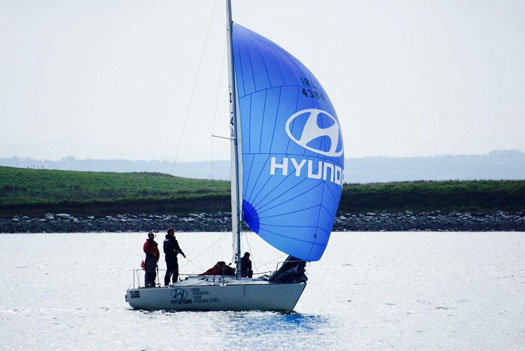
Crewed by Martin MacNamara, Thomas Whelan, Andrew Carey, Charlie Glynn and Diarmuid Whelan, the 2013 winners said they were honoured to take the title amongst stiff competition.
In the modern era, interest in the waterways is experiencing somewhat of a resurgence as more take to the water. Clubs in the region are noting an increase in membership.
Despite only having the plate in their possession for a few short hours, winners leave the West coast club in Kilrush with the honour of adding their names to a long list that is almost 180 years old.
Like many years before, the Royal Western Yacht Club of Ireland hosted the October series to determine the winner of the priceless Plate cast in Limerick silver and the competition lived up to its history.
Former Irish Lights Dun Laoghaire Harbour Based Buoy-Tender Sports New Shannonside Colours
#BuoyTender - Puffin, a former Commissioners of Irish Lights (CIL) buoy-tug tender which spent a career of almost three decades in Dun Laoghaire Harbour has recently been spruced up in new colours for current owners Shannon Workboats, writes Jehan Ashmore.
Puffin was very much a 'workhorse' for Irish Lights Dun Laoghaire based marine depot from where the vessel towed countless buoys back and forth to the various anchored 'lighthouse' tenders among them Atlanta, Granuaile and Gray Seal.
Arguably such workhorses can be easily forgotten or disregarded in a task perhaps perceived as mundane yet the role of the Puffin was an integral component in ensuring the operations of CIL.
The work of Puffin was vital bearing in mind the countless aids to navigation that dot around our island to assist safe passage not just to seafarers and ship cargoes but also passengers and leisure users too.
The Commissioners had Puffin custom-built from David Abels Boatbuilders of Bristol in 1984. It is understood that the small vessel of 12.4m long, beam of 3.8m and 1.5m draught was the last vessel launched from the Albion Dockyard.
When she was sold in 2011, the 24 gross tonnes vessel made her repositioning delivery voyage from Dun Laoghaire to the Shannon Estuary. The first leg to Baltimore took more than 30 hours and from where she took on bunkers before continuing on the final 20 hour-leg to Foynes.
She alongside Shannon Workboats fleetmate Islander are 'lines-boats' contracted to Rusal Aughinish Alumina, the largest alumina processing plant in Europe. Both workboats provide assistance in transferring mooring ropes between bulk-carriers docking and departing the double berth jetty.
The outer 285m berth can handle 90,000dwt vessels at depths of 12.4 metres and the inner 180m berth is for 40,000dwt ships in waters of 11 metres.
Examples to the type of bulk-carriers both large and small calling to Aughinish Jetty as previously reported on Afloat.ie are the 2009 Japanese built Panama-flagged Aom Julia, the 76,596dwt which was discharging bauxite. On the adjacent berth the South Korean built Arklow Mill of 14,990dwt was loading alumina bound for Rotterdam.
The plant's production process involves extracting alumina from imported bauxite that is discharged at the jetty. Approximately 70% of the bauxite originates from Guinea in west Africa and the balance from Brazil. The alumina (totalling 1.924m tonnes in 2012) is discharged from the same jetty for export where it is processed again through smelting into aluminium metal.
The lighthouse vessels are now referred as aids to navigation tenders with the current vessel the 2000-built ILV Granuaile. The 2,635 gross tonne vessel continues to anchor within the harbour's western bight off the West Pier. Instead of the Puffin, the towage of buoys continues to be maintained by smaller sized tenders belonging to the ILV Granuaile.
On a few occasions each year due to Spring tides, this procedure is not required as ILV Granuaile can moor alongside the berth at CIL's joint administration and marine depot.
Among the other tasks Puffin was gainfully employed was in the towage of the larger navigational aids such as Superbuoys and Large Automated Navigation Buoy's (LANBY). In 2010 Afloat.ie reported on the last LANBY.
In addition Puffin was not exclusively confined within the harbour as she would be required to transfer maintenance personnel to the automated Kish Lighthouse and Muglins lighthouse off Dalkey Island.
Her aft deck can handle up to 5–tonnes capacity and has proved useful. For example she loaded dismantled parts no longer required within the structure of the Kish Lighthouse and taken to Dun Laoghaire Harbour.
Puffin not only retains her original name but also her port of registry – Dun Laoghaire which is certainly most unusual to see for a vessel that is not a pleasure craft or yacht.
With the removal of Puffin's former CIL livery of grey hull colour and buff funnel, which also applied to the lighthouse tenders, the last been in this guise was the 1970 built Granuaile.The 2,003grt vessel as previously reported on Afloat.ie serves as Ocean Seeker for Gardline Marine Services based out of Great Yarmouth on the UK's Norfolk coast.
The current 'Granuaile' sports a blue hull likewise to her former fleetmate... the Puffin!
Loop Head Lighthouse Attracts 19,000 Visitors
#loophead – Figures released today show that over 19,000 people (14,101 adults, 5,082 children) visited Loop Head Lighthouse during the six-month opening period up to Sunday, 29 September.
Clare County Council, which manages the facility in conjunction with the Commissioners of Irish Lights (CIL), said preliminary estimates indicate that 75% of the total visitor figure was represented by domestic visitors, of which approximately 55% were holidaymakers and 30% were day trippers, with local visitors accounting for the remainder. Overseas visitors accounted for 25% of the total figure.
The Lighthouse was opened on a weekend basis from St Patricks Weekend until mid-May after which it was opened daily until the end of September. Opening hours were extended by two hours to 7.30pm during late July and August to accommodate the surge in visitor numbers to the West Clare landmark this summer.
The visitor figures, which represent a jump of 2,000 on the same period in 2012, coincide with the recent announcement that Loop Head Peninsula has been shortlisted alongside Burren & Cliffs of Moher Geopark and 6 other sustainable tourism destinations and organisations in the 'Best Destination for Responsible Tourism' category of the 10th annual 2013 World Responsible Tourism Awards. Other shortlisted locations include Bhutan, Bonito (Brazil) Nature Park & Glacier Region Kaunertal (Austria), Mara Naboisho Conservancy (Kenya), Valleys Regional Park (Wales) and Lithuania in the 'Best Destination for Responsible Tourism' category.
The awards ceremony, which is being hosted by World Travel Market, takes place on Wednesday 06 November during World Responsible Tourism Day, at the ExCeL London Exhibition and Convention Centre.
Loop Head Lighthouse, located at the mouth of the Shannon Estuary, is steeped in history and rich in maritime heritage with its origins dating back to the 1670s. The existing tower style lighthouse was constructed in 1854 and was operated and maintained by a keeper who lived within the lighthouse compound.
Taoiseach Enda Kenny's grandfather was a keeper at the lighthouse. James John McGinley took up duty at the Lighthouse as Principal Keeper on 16th January 1933. He spent 1 year and 10 months at Loop Head. He was transferred from the station in October 1934. In January 1991, the lighthouse was converted to automatic operation, and today is in the care of an attendant and is also monitored by the CIL.
Foynes Yacht Club Applauds Maximus & Marengo September Series Winners
The September series of racing concluded at Foynes Yacht Club on Sunday last writes Gerry Ryan.
The south-easterly wind with 15 knots of breeze ensured that superb racing took place east of Foynes Island. The Officer of the Day, vice commodore, James McCormack set a challenging course for the competitors. In Class 1 the boats raced to the 8 metre mark and back down to Sturamus and back up river to the 8 metre and back to the club finish line.
In the White Sails division the boats were sent to the 8 metre mark and down to Sturamus and home. In Class 1 Darragh McCormack in Maximus received the Dan O'Sullivan Cup; second was Dis-A-Ray, with Ray McGibney at the helm, and third was Battle with John-Paul Buckley as skpper. In the White Sails division, Pat Finucane in Marengo received the John Maher Cup; while Kerry Dream with Commodore Tom Murray on the helm.
The October series for Mermaids will be starting on Sunday next with first gun at 1pm. Racing will take place for the three Sunday's in October and on the Monday of the October bank holiday weekend.
Skipper and crews are asked to be at the clubhouse at 12noon on Sunday for a briefing.
The Royal Western Yacht Club will be hosting the annual October series from next Sunday. Details on this event are available on www.royalwesternyachtclub.com





























